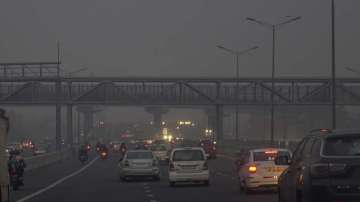Delhi's air quality was in the 'very poor' category on Sunday and deteriorated to the 'severe category' in some areas, with forecasters saying that slow wind speed and an increase in stubble burning, especially in Punjab, may make it worse. The share of stubble burning in Delhi's PM2.5 pollution rose to 26 percent on Sunday, the highest this year.
Delhi's overall air quality index (AQI) stood at 367 at 9 am and it improved to 352 at 4 pm. The 24-hour average AQI on Saturday was 397, the worst since January. It was 354 on Thursday, 271 on Wednesday, 302 on Tuesday and 312 on Monday (Diwali). On Sunday, Anand Vihar (AQI 449) was the most polluted place in the capital, followed by Vivek Vihar (402).
Environment Minister Gopal Rai said Anand Vihar and Vivek Vihar have been reporting high pollution levels continuously which could be due to construction work related to Regional Rapid Transit System (RRTS). "Therefore, we have directed the user agency to strictly follow the dust pollution control norms. The government has deployed 15 anti-smog guns in those areas in addition to seven water sprinklers of the Municipal Corporation of Delhi," he said. "Diesel-run buses have an important role in high pollution levels at the Delhi-UP border. We request the UP government to run CNG buses in the NCR districts at least. This will help bring down air pollution," the minister said.
Stubble burning contributes 26% to air quality
Stubble burning accounted for 26 per cent of the PM2.5 pollution in Delhi on Sunday and forecasters said it is likely to rise in the coming days. The Indian Agricultural Research Institute (IARI) reported 1,761 farm fires in Punjab on Sunday, 1,898 on Saturday, 2,067 - the highest so far this season - on Friday and 1,111 on Thursday. It logged 112 and 43 cases of stubble burning in Haryana and Uttar Pradesh, respectively, on Sunday.
The Commission for Air Quality Management had on Thursday said the increased incidents of stubble burning in Punjab this year "is a matter of serious concern". According to satellite remote sensing data, up to October 24, only about 39 per cent of the sown area in Punjab had been harvested and thus the rising number of fire events was an alarming situation, it said.
With pollution levels worsening, the Centre's air quality panel on Saturday directed authorities to impose a ban on construction and demolition activities in Delhi-NCR, except in essential projects, and other curbs under stage III of the Graded Response Action Plan. Rai on Sunday said the Delhi government has set up 586 teams to ensure strict implementation of the ban on construction and demolition activities in the capital in view of worsening air quality. GRAP is a set of anti-air pollution measures followed in the capital and its vicinity according to the severity of the situation.
It classifies the air quality in the Delhi-NCR under four different stages: Stage I - 'Poor' (AQI 201-300); Stage II - 'Very Poor' (AQI 301-400); Stage III - 'Severe' (AQI 401-450); and Stage IV - 'Severe Plus' (AQI >450). Under stage III, the authorities have been asked to enforce a strict ban on construction and demolition activities in the NCR, except for essential projects and non-polluting activities such as plumbing, carpentry, interior decoration and electrical works.
The construction ban will not be applicable to projects concerning national security, defence, railways and metro rail among others. However, it is likely to affect housing projects in Noida, Ghaziabad, Gurugram and other areas. Mining activities will not be allowed in the region. The next stage in the "Severe Plus" category or Stage IV can include steps like a ban on the entry of trucks into Delhi, allowing 50 per cent of staff to work from home in public, municipal and private offices, closure of educational institutions and the plying of vehicles on an odd-even basis, etc.
ALSO READ | Delhi air pollution: What all will be affected as GRAP stage III kicks in
ALSO READ | Rains delayed harvesting, expect clustering of stubble burning incidents: Experts
Latest India News
